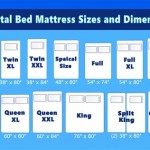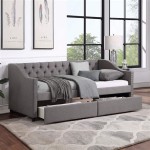Measurements of Queen and King Size Beds
Choosing the right bed size is crucial for a comfortable and restful sleep. While personal preferences play a role, understanding the standard dimensions of popular bed sizes, especially queen and king, is essential for making an informed decision. This article delves into the measurements of queen and king size beds, providing insights into their characteristics and potential advantages and disadvantages.
Queen Size Bed Dimensions
A queen size bed offers ample sleeping space for two individuals. Its standard dimensions are 60 inches wide and 80 inches long. This size provides a generous surface area for sleeping, allowing for ample room to move around without disturbing your partner. However, it's important to consider the overall bedroom size, as a queen bed can occupy a significant portion of the space.
Queen size beds are versatile and can be found in various styles, including platform beds, sleigh beds, and canopy beds. They are suitable for couples and single individuals who desire a larger bed surface but prefer a smaller footprint compared to king-size beds.
King Size Bed Dimensions
A king-size bed reigns supreme in terms of spaciousness. It boasts dimensions of 76 inches wide and 80 inches long, providing an expansive sleeping area. This wide, luxurious bed offers ample room for couples to spread out comfortably, minimizing the possibility of feeling cramped. The additional width can be particularly beneficial for individuals who sleep on their sides, providing a greater range of motion.
While king-size beds offer unparalleled comfort, their size can be a factor to consider. They require a larger bedroom and may not be ideal for smaller spaces. Additionally, finding bedding and other accessories like sheets and comforters in king size can be more challenging and potentially more expensive.
Choosing the Right Bed Size for Your Needs
Ultimately, the best bed size for you depends on your individual needs and preferences. Consider the following factors:
- Sleeping habits: Do you tend to spread out while sleeping or sleep close to your partner?
- Bedroom size: Measure your bedroom carefully to ensure the chosen bed fits comfortably without feeling cramped.
- Budget: King-size beds often come with a higher price tag than queen-size beds.
- Lifestyle: Do you frequently host overnight guests or prefer a more intimate setting?
By carefully evaluating these factors, you can select a bed size that aligns with your lifestyle and provides optimal comfort and functionality.
Additional Considerations for Queen and King Size Beds
Beyond the standard dimensions, there are several additional factors to consider when choosing a queen or king-size bed:
- Headboard: The height and style of the headboard can significantly impact the overall look and feel of the bedroom. Choose a headboard that complements the bedroom's aesthetic and provides the desired level of support.
- Footboard: Footboards add a decorative element to the bed and can provide practical storage space.
- Mattress: Choose a high-quality mattress that supports your body and provides the desired level of firmness or softness.
- Bedding: Queen and king-size beds require larger sheets, comforters, and bedding accessories. Ensure you have access to these items in the desired size and style.
By carefully considering the measurements, additional features, and individual needs, you can select a queen or king-size bed that provides a comfortable and restful sleep experience.

The Difference Between A Queen And King Bed Bedinabox

Mattress Sizes Chart And Bed Dimensions Guide Amerisleep

King Vs Queen Bed What S The Difference Amerisleep

Bed Sizes The And Mattress Size Guide

King Vs Queen Bed Size Mattress What Is The Difference Nectar Sleep

King Vs Queen Bed Detailed Mattress Comparison Turmerry

Queen Bed Dimensions A Guide Nectar Sleep

Image Result For Size Bed Dimensions Metric Queen Frame Sizes
Which Mattress Is Bigger Queen Or King Quora

Homebliss The Hippest Community For Home Interiors And Design
Related Posts







